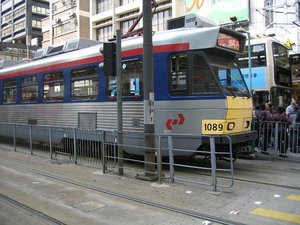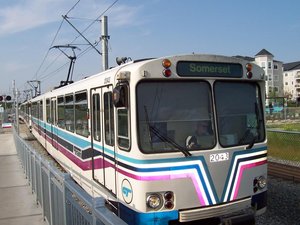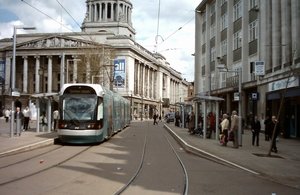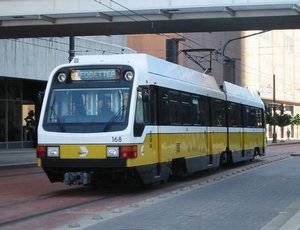Light rail
|
|
- This article talks about urban rail systems with certain characteristics, usually running at least partially on the surface but with relatively high capacity. For a treatment of transit in cities in general, see urban rail transit. For terminology, see passenger rail terminology. For higher-order systems with fuller grade separation and higher capacity, see rapid transit (despite some of these having "light rail" or "light railway" in their name). For lower-order systems similar to light rail, see tram.
- For specific light rail systems, many of which use the words "light rail" as part of their name, see list of light rail transit systems.
Hiawatha_LRV.jpg
HBLR-Hudson_Street.jpg
Metrolink_tram.jpg
Sheffield_Supertram.JPG
Light rail or light rail transit (LRT) is a particular class of urban and suburban passenger railway that utilizes equipment and infrastructure that is typically less massive than that used for rapid transit systems, with modern light rail vehicles usually running along the system.
Light rail is the successor term to streetcars, trolleys and trams in many locales, although the term is most consistently applied to modern or modernised tram or trolley operations employing features more usually associated with metro or subway operations, including exclusive rights-of-way, multiple unit train configuration and signal control of operations.
The term light rail is derived from the British English term light railway long used to distinguish tram operations from steam railway lines, as well as from its usually lighter infrastructure. The term was adopted in the 1970s, particularly in the United States, as a conscious break from the obsolescent image of streetcars. It is sometimes used largely for political reasons; in Toronto, the city Transit Commission had to rename a recent project to build a dedicated right of way for one of its streetcar lines as a 'new, modern LRT' in order to obtain the support of politicians, and then change it back to a 'normal, familiar streetcar' to be accepted by the area's residents (the actual project was the same the entire time).
Light rail traces its pedigree to street railways, whereas rapid transit (metro) technology evolved from steam commuter operations, such as were seen in London, New York City, and Chicago.
Light rail systems are almost universally operated by electricity delivered through overhead lines, although several systems are powered through different means, such as the JFK Airtrain, which uses a standard third rail for its electrical power, and trams in Bordeaux which use a special third-rail configuration in which the rail is only powered while a tram is on top of it (making it safe to install third rails even on city streets). A few unusual systems such as the River Line in New Jersey and the O-Train in Ottawa use diesel-powered trains, though this is sometimes intended as an interim measure until the funds to install electric power become available.
| Contents |
Attempting to define "light rail"
Most rail technologies, including high-speed, freight, commuter/regional, and metro/subway are considered to be "heavy rail" in comparison. A few systems such as people movers and personal rapid transit could be considered as even "lighter", at least in terms of how many passengers are moved per vehicle and the speed at which they travel. Monorails are also considered to be a separate technology. Light rail systems can handle steeper inclines than heavy rail, and curves sharp enough to fit within street intersections (though this is hardly true for all light-rail lines). They are typically built in urban areas, providing frequent service with small, light trains or single cars.
The most difficult distinction to draw is that between light rail and streetcar or tram systems. There is a significant amount of overlap between the technologies, and it is common to classify streetcars/trams as a subtype of light rail rather than as a distinct type of transportation. The two general versions are:
- The traditional type, where the tracks and trains run along the streets and share space with road traffic. Stops tend to be very frequent, but little effort is made to set up special stations. Because space is shared, the tracks are usually visually unobtrusive.
- A more modern variation, where the trains tend to run along their own right-of-way and are often separated from road traffic. Stops are generally less frequent, and the vehicles are often boarded from a platform. Tracks are highly visible, and in some cases significant effort is expended to keep traffic away through the use of special signaling and even grade crossings with gate arms. At the highest degree of separation, it can be difficult to draw the line between light rail and metros, as in the case of London's Docklands Light Railway, which would likely not be considered 'light' were it not for the contrast between it and the London Underground.
Many light rail systems — even fairly old ones — have a combination of the two, with both on road and off road sections. In some countries, only the latter is described as light rail. In those places, trams running on mixed right of way are not regarded as light rail, but considered distinctly as streetcars or trams. However, the requirement for saying that a rail line is "separated" can be quite minimal — sometimes just with concrete "buttons" to discourage automobile drivers from getting onto the tracks.
There is a significant difference in cost between these different classes of light rail transit. The traditional style is often less expensive by a factor of two or more. Despite the increased cost, the more modern variation (which can be considered as "heavier" than old streetcar systems, even though it's called "light rail") is the dominant form of urban rail development in the United States. The Federal Transit Administration helps to fund many projects, but as of 2004, the rules to determine which projects will be funded are biased against the simpler streetcar systems (partly because the vehicles tend to be somewhat slower). Some places in the country have set about building the less expensive streetcar lines themselves or with only minimal federal support. Most of these lines have been "heritage" railways, using refurbished or replica streetcars harkening back to the first half of the 20th century. However, a few, such as the Portland Streetcar, use modern vehicles. There is a growing desire to push the Federal Transit Administartion to help fund these startup lines as well.
Light rail is generally powered by electricity, usually by means of overhead wires, but sometimes by a live rail, also called third rail (a high voltage bar alongside the track), requiring safety measures and warnings to the public not to touch it. In some cases, particularly when initial funds are limited, diesel-powered versions have been used, but it is not a preferred option. Some systems, such as the JFK Airtrain in New York City, are automatic, dispensing with the need for a driver; however, such systems are not what is generally thought of as light rail. Automatic operation is more common in smaller people mover systems than in light rail systems, where the possibility of grade crossings and street running make driverless operation of the latter inappropriate.
History
From the mid-19th century onwards, horse-drawn trams (or horsecars) were used in many cities around the world. In the late 1880s electrically-powered street railways became technically feasible following the invention of a trolley system of collecting current by American inventor Frank J. Sprague who installed the first successful system at Richmond, Virginia. They became popular because roads were then poorly surfaced, and before the invention of the internal combustion engine and the advent of motor-buses, they were the only practical means of public transport around cities.
The light rail systems constructed in the 19th and early 20th centuries typically only ran in single-car setups. Some rail lines experimented with multiple unit configurations, where streetcars were joined together to make short trains, but this didn't become common until later. When lines were build over longer distances (typically with a single track) before good roads were common, they were generally called interurban streetcars in North America or radial railways in Ontario.
In North America, many of these original light-rail systems were decommissioned in the 1950s and onward as the popularity of the automobile increased. Although some traditional trolley or tram systems still exist to this day, the term "light rail" has come to mean a different type of rail system. Beginning in the 1980s, some cities began reintroducing light-rail systems that are more like subway or metro systems that operate at street level. These light-rail systems include modern, multi-car trains that can only be accessed at stations that are spaced anywhere from a couple blocks to a mile or more apart. Some of these systems operate within roadways alongside automobile traffic, and others operate on their own separate right-of-way.
As with other rail systems, the rail gauge has had considerable variations, but today standard gauge is dominant. Narrow gauge was common in many earlier systems, although as systems merged or died out, old lines were often upgraded, removed, or replaced. Some systems still use other track gauges, however.
Advantages of light rail
Light rail systems are generally cheaper to build than heavy rail, since the infrastructure does not need to be as substantial, and tunnels are generally not required as is the case with most metro systems. Moreover, the ability to handle sharp curves and steep gradients can reduce the amount of work required.
Traditional streetcar systems as well as newer light rail systems are used in many cities around the world because they typically can carry a larger number of people than any bus-based public transport system. They are also cleaner, quieter, more comfortable, and in many cases faster than buses. In an emergency, light rail trains are easier to evacuate than monorail or elevated rapid rail trains.
Many modern light rail projects re-use parts of old rail networks, such as abandoned industrial rail lines.
A good example of both points above is the Docklands Light Railway (DLR) in London, which uses a sharp, steep, curve to enable it to transfer from running alongside an existing railway line to a disused railway line which crossed underneath the first line. A direct connection between these lines would not be practical for conventional rail (note that because the DLR has a completely grade-separated right of way, it can also be regarded as a metro).
Disadvantages of light rail
Like all modes of rail transport, light rail tends to be safest when operating in dedicated right-of-way with complete grade separations. However, grade separations are not always financially or physically feasible.
In California, the development of light rail systems in Los Angeles and San Jose led to a high rate of collisions between automobiles and trolleys during the 1990s. The most common cause was that many senior citizens were unfamiliar with light rail trolleys and often mistook the trolley "T" signal lights for left-turn signal lights. They would then make a left turn, right into the path of a trolley. The same high crash rate problem existed when the METRORail was first established in Houston, Texas.
To reduce such collisions, brighter lights and louder warning klaxons have been added to many at-grade crossings. However, as a result, many people do not like to live next to light rail crossings because the noise makes it impossible to sleep. A more effective means of reducing or preventing automobile-light rail collisions has been the installation of quad crossing gates at gate crossings. These gates block both lanes of a street as the gate closes. These prevent those driving automobiles from driving around the gates when they are lowered.
Monorail advocates like to point out that light rail trolleys are heavier per pound of cargo carried than heavy rail cars or monorail cars, because they must be designed to survive collisions with automobiles.
Unusual variations
Trams operating on mainline railways
Around Karlsruhe and Saarbrücken, Germany, Bombardier Flexity Link trams partly use heavy-rail tracks, sharing these tracks with heavy-rail trains. In the Netherlands this was first applied on the RijnGouweLijn. This allows commuters to ride directly into the city centre, rather than having to take a mainline train as far as a central station and then change to a tram.
Some of the issues involved in such schemes are:
- compatibility of the safety systems
- power supply of the track in relation to the power used by the vehicles (different voltages, and third rail vs overhead wires)
- width of the vehicles in relation to the position of the platforms
- height of the platforms
There is history of what would now be considered light-rail vehicles operating on heavy-rail rapid transit tracks in the U.S., especially in the case of interurban streetcars. Notable examples are Lehigh Valley Transit trains running on the Philadelphia and Western Railroad high-speed third rail line (now the Norristown High Speed Line, and Chicago, North Shore and Milwaukee Railroad and Chicago, Aurora and Elgin Railway interurbans reaching downtown Chicago via the Chicago L. Such arrangements are almost impossible now, due to the Federal Railroad Administration refusing to allow non-FRA compliant railcars (i.e., subway and light rail vehicles) to run on the same tracks at the same times as compliant railcars, which includes locomotives and standard railroad passenger and freight equipment. A notable exception is the New Jersey Transit River LINE from Camden, New Jersey to Trenton, New Jersey, which has received an exemption on the provision that light rail operate only during the daytime hours and Conrail freight only at night, with several hours separating one operation from the other.
Third-rail power for trams
In the French city of Bordeaux, Citadis trams are powered by a third rail even in the city centre, where the tracks are not always segregated from pedestrians and cars. Safety is ensured by placing the third rail between the other two, and dividing it into eight-metre sections, each of which is only powered while it is completely covered by a tram. There is therefore no risk of a person or animal coming into contact with a live rail. In outer areas, the trams switch to conventional overhead wires. See this LRTA report (http://www.lrta.org/art0212.html) for more information.
This third rail technology is being investigated for use on the Gold Coast of Australia in the Gold Coast Light Rail Feasibility Study. See the present draft report (http://www.pb.com.au/gclightrail) here.
See also
- List of light rail transit systems
- Bus Rapid Transit
- cable car
- people mover
- monorail
- electric trolleybus
- public transport
- tram
- streetcar
- General Motors Streetcar Conspiracy
- metro
- tram-train
External links
- List of Canadian urban rail systems (http://www.rinbad.demon.co.uk/ca_rail.htm)
- Table of Light Rail Transit Agencies in the United States (http://apta.com/links/transit_by_mode/lightrail.cfm)
- Light Rail Transit Association (http://www.lrta.org/) (GB)
- Light Rail Central (http://lightrail.com/) (US/CA)
- Light Rail Now advocacy (http://www.lightrailnow.org/) (US)
- Light Rail Netherlands (http://www.lightrail.nl/) (NL) in English, Nederlands, Русский язык, Deutsch, Français, Español
- The Library of Congress (http://memory.loc.gov) has a movie of Armour's electric trolley, circa 1897. Search for "Armour's+electric+trolley"da:Letbane
de:Stadtbahn fr:Tram-train nl:Lightrail ja:ライトレール pt:Light rail ru:Легкорельсовый транспорт sl:Mestna železnica sv:Spårväg zh-tw:輕鐵




